FAT SET for PSYC2071 midterm
1/334
There's no tags or description
Looks like no tags are added yet.
Name | Mastery | Learn | Test | Matching | Spaced |
|---|
No study sessions yet.
335 Terms
What is important to note about the ‘independence’ of sensory input?
the idea that you cannot really determine the ‘truth’ behind an input.
Define the idea of the output and the input?
Input is manipulated
Output is measured.
Why is the brain a black box?
We don’t really know what turns an input into an output → we may know locations and see similarities between people when certain regions are activated, but we don’t really know what's inside the black box.
What are the stages of perceptual processes?
Environmental stimuli is produced
Sensory receptors transducts stimuli into signal
Signal is encoded into neural representations
this ultimately results in a percept
Consider each output to be the input of the next stage.
What is signal detection theory?
Explores how well we can distinguish one signal from another. States that there is a criterion that distinguishes if signals are the same or different. This is normally represented in the form of 2 x population curves, which naturally has true positives/negatives, false alarms and false negatives.
Signal detection theory using false alarms as well as hits allows us to actually consider sensitivity, rather than just simply percentage correct.
Sensitivity → in the context of 2 x curves is the distance between two curves.
What is Sensitivity in the context of signal detection theory?
→ in the context of 2 x curves is the distance between two curves.
How can you apply the signal theory to other situations?
Can be used to measure how much information is present in remembered events, faces and information (generally).
What is a photoreceptor?
All or nothing signal - systematic relationship between wavelength and likelihood of detection. → well-characterised relationship.
What is the principle of univariance?
the response of a single photoreceptor cannot distinguish between different wavelengths of light, since its response depends on both wavelength and intensity.;
action potiental - on or off
How does the principle of invariance suffer in higher order information processing ?
e.g in a social media example - people may ‘like’ posts, but we may not be able to determine the content of these posts. The only thing we may be able to determine is the shared characteristics of these posts.
What are the main characteristics of perception?
Cognitive Impenetrability → whether or not explicit knowledge of image structure does influence its perceived properties → e,g shepherds tables illusions
Perceptual competencies emerge early in development → generally easy to emerge and sophisticated even very early in development.
Emergent properties - the fact that the whole is more than the sum of its parts - we are able to infer a lot even if the stimuli is not a lot - perceptual stimulation allows for emergent properties that allow for interactions with the environment.
Despite the richness of the perceptual experience, perceptual representations of external stimuli are not very detailed. e.g. change blindness
Cognitive impenetrability: Perception is not easily altered by explicit knowledge — knowing about an illusion (e.g., Shepard’s tables) doesn’t change how it looks.
Early perceptual competencies: Perceptual abilities develop early and become quite sophisticated with minimal experience.
Emergent properties: Perception involves seeing more than the sum of parts — we can infer meaningful wholes even from limited stimuli, aiding environmental interaction.
Limited perceptual detail: Despite feeling rich, perceptual representations lack fine detail (e.g., change blindness).
🔹 C – Cognitive Impenetrability
Knowing about an illusion doesn’t change how it looks (e.g., Shepard’s tables).
🔹 E – Early Perceptual Competence
Perceptual skills develop early and are surprisingly sophisticated.
🔹 E – Emergent Properties
The whole is greater than the sum of its parts — perception infers meaning from limited input.
🔹 L – Limited Detail
Perceptual representations feel rich but lack detail (e.g., change blindness).
What is the visual angle?
Eye centered measure of distance.
What is common terminology for describing visual information?
Visual angle - eye centered measure of distance - 1 cm at 57cm away is 1 degree of visual angle away.
Contrast - difference between light and dark
Spatial frequency -rate of change over space
Temporal frequency - rate of change over time
What is common across the different ways of describing visual information
Three of the four terminologies describe ways that an image changes over space, or of the difference between parts of the image.
Shows that our visual systems are maximally sensitive to what is changing over space or time, not what is staying constant.
What are the different types of cells in the retina?
Photoreceptor connect to the (110 million )
Bipolar cells connect to the (10 millions)
Retinal ganglion cells connect to the optical nerves (1.2 million)
The amount of information processed slowly decreases as evident by number of cells at each stage.
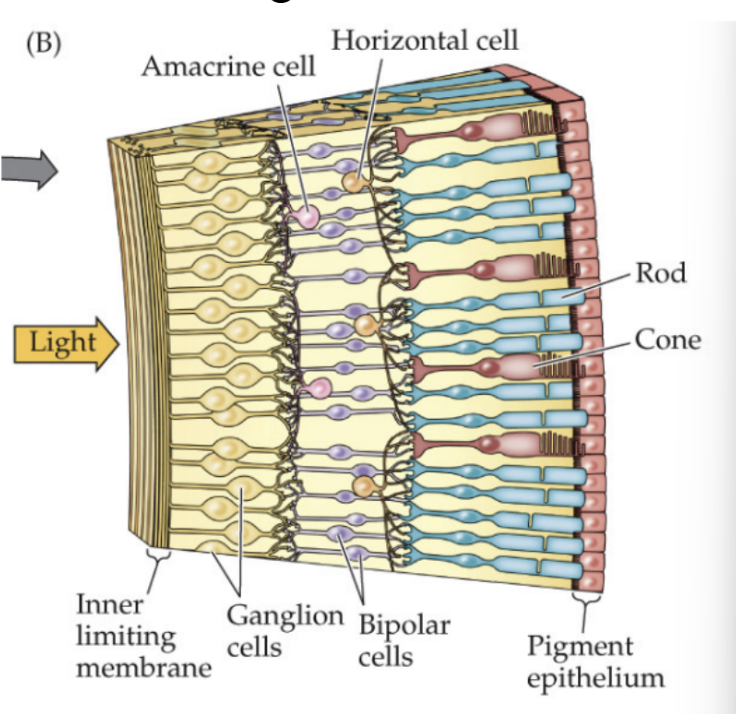
Why is the optical nerve limited?
In order to ensure that we can still move our eyes, the number of retinal ganglion cells is limited as the cell’s axons extend to the optical nerve. This ensures that we can still move our eyes or else the muscles are too limited
This also gives rise to our blindspot.
What are the two types of photoreceptors?
Rods (90-100 million) and Cones
What is the difference between the central and peripheral vision?
There are two different pathways in the eye. The central retinal pathway and the peripheral pathway. These amount to differences in acuity and sensitivity.
What is the pathway associated with the central pathway?
One L foveal cone is associated with 2 x bipolar cells that can turn off and one, each of these bipolar cells is associated with an on or off ganglion cell/
Note that in the central pathway, there is much more cones connected to the bipolar cells, compared to peripheral pathway in order to account for the reduction of cells from stage to stage.
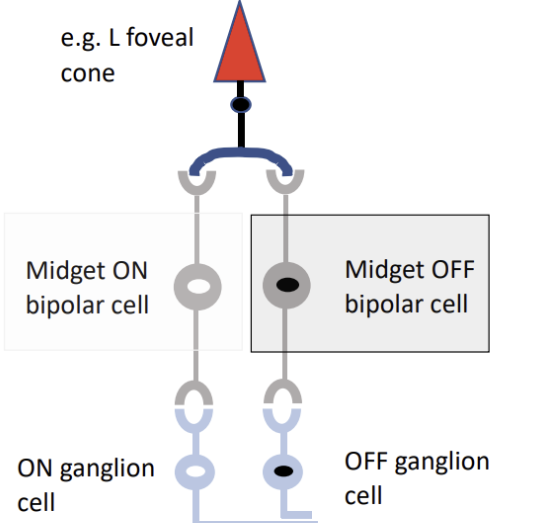
What is the peripheral pathway ?
In this pathway there are many rod/cone photo receptors connected to one bipolar cell, which then link to ganglion cells etc .
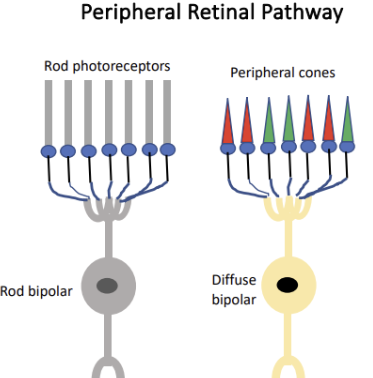

What is the difference between divergence and convergence and what does it means for acuity and sensitivity?
Divergence:
one to many
- associated with the central retinal pathway - increase acuity but decrease efficiency - by allowing a single signal from a photoreceptor to be processed by multiple, parallel pathways, enhancing spatial resolution.
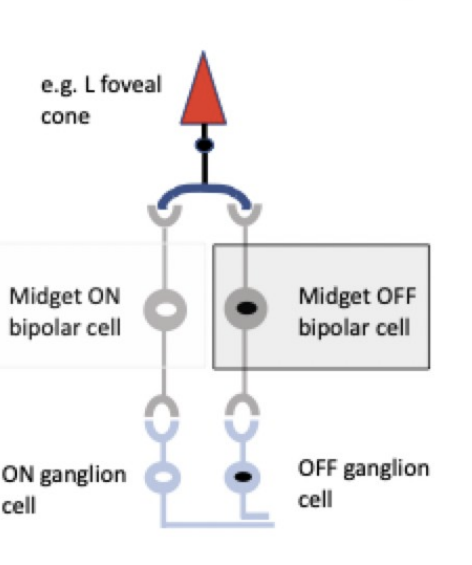
Convergence:
many to one.
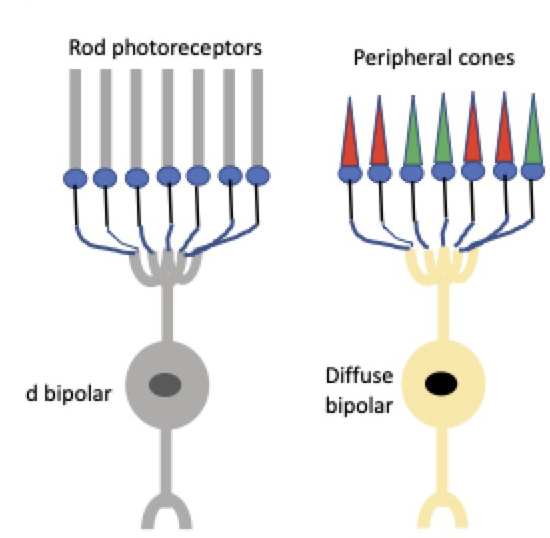
- associated with the peripheral pathway - decreases acuity, but increases efficiency and sensitivity (summing together signals) . ;
What is a receptive field?
A receptive field is an area in space which when occupied by an appropriate stimulus affects the firing rate or activity of a neuron receptive fields of retinal bipolar and ganglion cells have concentric circular centre and surround zones.
What is and are the differences between the ON-centre and the OFF-centre receptor field?
Every rod bipolar cell has a receptor field - of which - if activated or not - has an ON-centre receptor field or OFF-centre receptor field.
ON-centre receptive field
What happens in the ON-centre receptive field?
Light in centre increases firing rate -
Light in surround region decreases firing rate
What happens in the OFF-centre receptive field?
Light in the centre decreases firing rate -
Light in the surrounding region increases firing rate.
Why is there both an ON and an OFF for receptive fields?
Way to increase clarity , without decreasing efficiency. Generally, enables equal sensitivity and rapid information transfer for both increments and decrements - Divergence increases acuity (but is more ‘expensive’).
What is the effect of sizes on the receptive field?
Retinal ganglion cells with different receptive field sizes sample intensity variations at different spatial scales (ie respond to different spatial frequencies)
What are the functional consequences of On/Off (opponent) receptive fields?
Facilitates high sensitivity to changes in intensity over space or time.
Maximum sensitivity to differences between the centre and the surround regions (contrast), less affected by the average intensity of the light
What are the applications of the On/Of receptor fields?
Image Compression
What is the difference between Magno and Parvo cells?
These are two different types of retinal ganglion cells.
What is the relationship between receptive field and spatial frequency?
Large receptive field size -> Low spatial frequency filter
Small receptive field size -> High spatial frequency filter.
What is the principle of univariance?
the response of a single photoreceptor cannot distinguish between different wavelengths of light, since its response depends on both wavelength and intensity.;
What are the magnocellular vs parocellular pathways?
Are associated with the cells are the end of the ganglion - parasol vs. magno ganglion.
The parvocellular pathway is associated with reading, or searching for a face in the crowd (aka spatial acuity) —→ gives always red-green colour
The Magnocellular pathway is associated with peripheral vision e.g noticing a ball flying towards your face
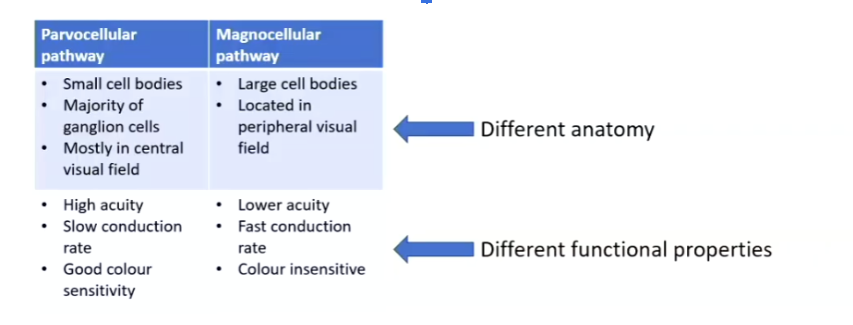

What is the LGN?
Lateral Geniculate Nucleus (LGN) is a crucial part of the thalamus in the brain that acts as the main relay station for visual information, receiving input from the retina and sending it to the visual cortex for processing.
Each layer receives inputs from either the left or the right eye where the signal is processed may be ipsilateral or contralateral
What to note about left hemispheres vs. right hemispheres?
Left hemisphere = right visual field
Right hemisphere = left visual field, However, the input does are not necessarily united immediately.
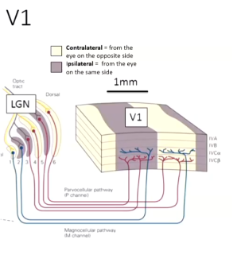

What is cortical magnification?
The idea that vision in the fovea (center of the image) has the best acuity, compared to peripheral acuity is reduced.
Cortical magnification refers to the idea that this happens because of
Higher numbers of photoreceptors in the centre, compared to the edge
Higher pooling of receptor fields in the edge compared to the centre.
What is a key difference between processing of vision in V1 vs. the LGN?
The fact that receptive fields of vision change from being circular, to being elongated. This means that in the V1 cells are more able to detect straight line changes compared to earlier visual processing, cells for vision become tuned for orientation.
Describe orientation tuning of V1 cells?
Within the V1 there are different cells turned to different orientations. This allows for receptive fields that are more able to detect different types of orientations. One neuron may refer to vertical orientation vs. another which prefers horizontal.
Cells are organised based on their orientational turning, cells are grouped depending on their preference into columns into orientation pinwheels that come to represent all orientations equally.
What are three things to remember about things that occur in the higher visual areas ?
Moving from the beginning to the end of processing, the brain processes increasingly complex features and have larger receptive fields.
These areas are not separated into the P/M pathways of the retina and LGN, and are increasingly interconnected
There is a broad separation into the ventral and dorsal streams of vision .
What is the difference between the ventral and dorsal pathways?
Ventral is associated with vision for perfection - associated with parvocellular
Dorsal is associated with vision for action - magnocellular → processing of motion.
What is optic flow and what is it used for ?
where the motion information in the stimulus can be used to infer the direction you're travelling in. This is important for survival generally as well as a cue to help us balance.
What is a space-time-plot?
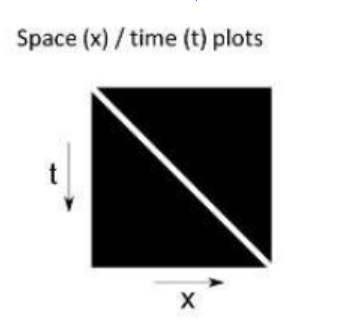

Do people change over space and time separately, and then combine these pieces of information to infer motion?
Our brains contain mechanisms that are directly sensitive to motion, so although we can break down the stimulus into change over space and time, our brain contains mechanisms that are sensitive to the combination of these two.
What is opponent coding of opposite motion directions?
It refers to the fact that motion moving faster to the right is coded in an equivalent way to moving more slowly to the left.
This also give rise to motion aftereffects , like the waterfall illusion.
What is the MT area?
Is an area of the brain that is very strongly implicated in motion perception, illustrates that the separation of function is much less distinct in cortex than it is in the subcortical pathways, generally associated with motion.
Electrical stimulation of this area can cause the perception of motion.
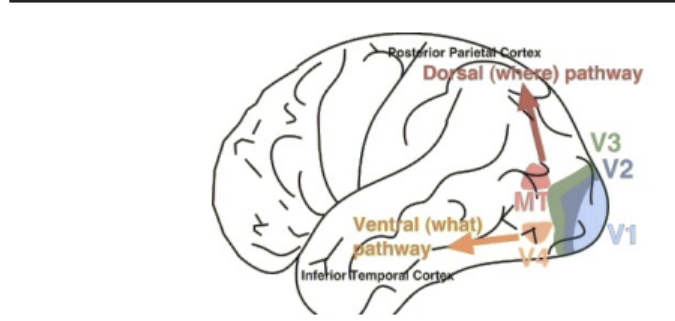

What does damage to the MT cause?
A condition called akinetopsia or motion blindness, isn't able to perceive motion.
However, still able to preserve static acuity, ability to read, colour vision and object recognition. So all the visual abilities we associate with the ventral stream are preserved. Interestingly, they also have a preserved ability to detect tactile motion and auditory motion. So area MT isn’t the only motion processing region in the brain, but it’s crucially implicated in visual motion
How does the brain suppress all this behaviourally irrelevant image motion so that only the extrinsic motion remains? (AKA you are walking and looking? But only getting the important motion information)
Efference copies/ corollary discharges for eye movements, wherein the brain creates a prediction of what image motion is going to result from the eye movement. This process is pre-emptive, rather than reactive.
This can be concluded from the signal processing responses of neurons in the frontal cortex. Some neurons remap image locations that they are able to be responding to, and some theorise that this remapping allows for the extrinsic motion to be perceived appropriately.
What is colour useful for?
Scene segmentation – as an extra cue to distinguish shadows from surfaces changes
Signalling surface – for example to tell the edibility of a banana, or to tell emotion/health.
What are the low level aspects of colour visual?
Retinal ‘hardware’
Retinal ‘software’
Anomalous colour vision.
Retinal ‘hardware’
What is retinal hardware for colour vision?
Namely the photoreceptor, note that the sensitivity of photoreceptors determines the range of wavelengths we are sensitive to. The number of differently sensitive photoreceptors gives the maximum dimensionality of our colour vision.
Explain wavelengths?
Different wavelengths are perceived differently for different species.
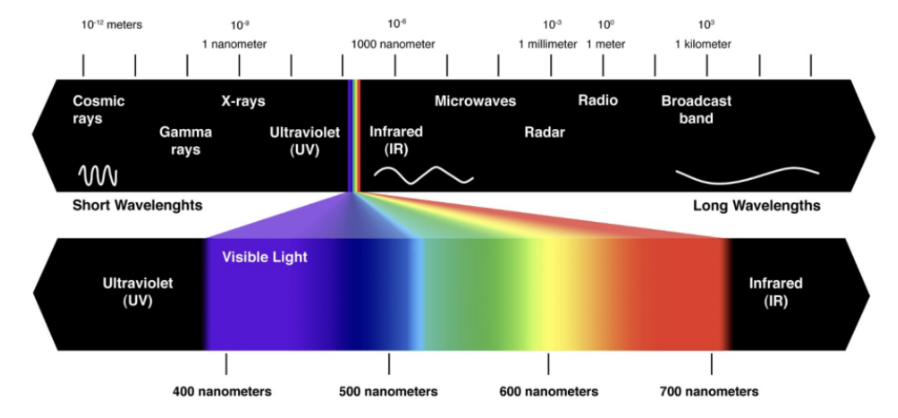

What is a Metamer?
Different stimuli that are perceptually indistinguishable, demonstrates why we don’t use wavelengths as a way of identifying colours, a colour may actually appear the same even through their wavelengths may be the same
Explain what is an L-M-S space?
A better understanding may also be sought via the L+M+S space which adds in light vs. dark as well.
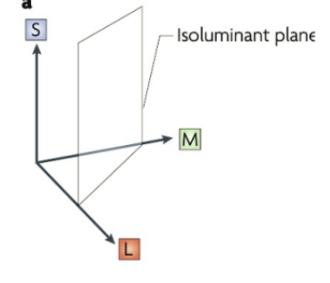
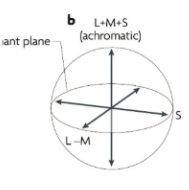
What does CMYK and why is there one more dimension?
May have an extra dimension, but this does not mean that it allows for perception.
To perceive colour we need to register the relative responses (difference) of different photoreceptors -> we lack the neural ‘software’ for 4D colour vision.
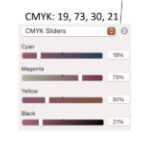
Retinal Software
Where does the M-tone come from?
Among mammals, only some primates have trichromatic vision, others are dichromats, with an S-cone and L-cone photoreceptor. • An L-cone mutation is thought to have resulted in the M-cone.
How did we already have the software to process the new cone?
Based on the parvocellular pathway we can see that we already had software for red-green colour vision.
What is the Konicellular pathway?
carries S-cone information, giving the ‘blue-yellow’ dimension to our colour vision, separate retinal ganglion cell types, e.g. small bistratified.
What is opponent coding of colour?
‘more red’ = ‘less green’ • ‘more blue’ = ‘less yellow’
This can be demonstrated via negative after-image (adaptation - prolonged looking) gives negative afterimages. Initial responses to changes in colour are higher, we pay attention to changes, rather than the state of actual events. Means our vision is relative
Describe anomalous colour vision?
Can be missing 2 x cones → translates into congenital achromatopsia
Can be missing 1 x cone → translates into a loss of colour space, rather than a missing colour.
What did Ewald Hering note?
Ewald Hering (1834-1918) noticed that some colour combinations are ‘legal’ while others are ‘illegal’ • Bluish green is legal / bluish yellow is illegal • Reddish yellow is legal / reddish green is illegal • Hypothesised the opponent coding of colour vision before retinal physiology was known.
What are the different ways you can lose a dimension due to missing a cone?
Normal (trichromatic)
Missing S-cone (tritanopia) - have only yellow - blue
Missing M-cone (deuteranopia) - no red - green
Missing L-cone (protanopia) - no red - green
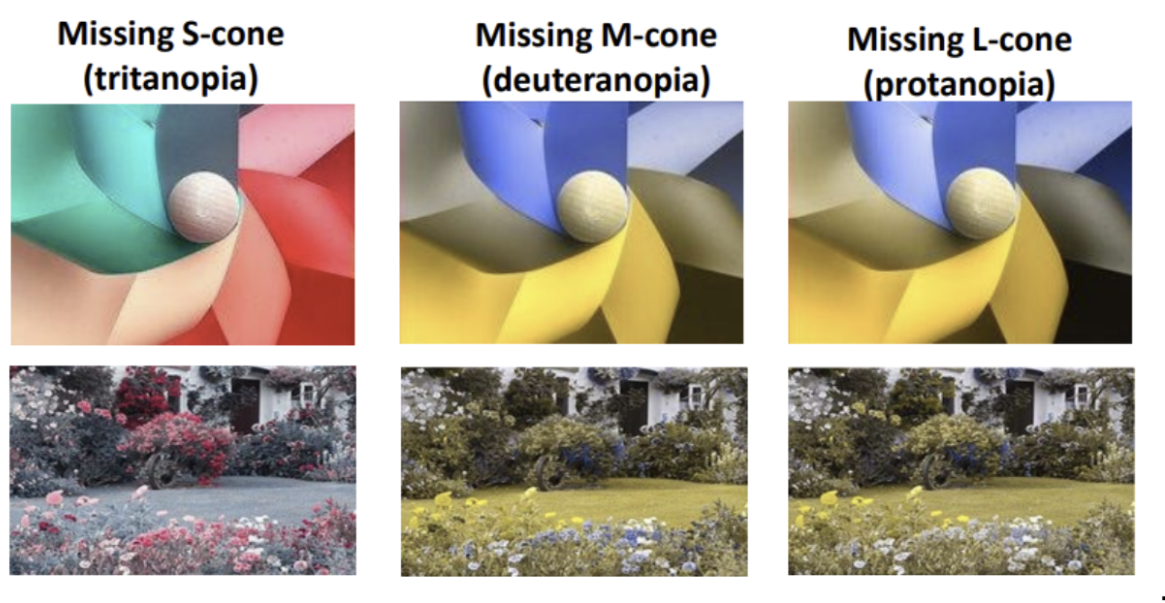

What are pseudochromatic plates?
have patterns that are restricted to variation along one dimension, with ‘noise’ in the other dimensions. YOU CAN SEE THE NUMBER IF YOU HAVE NORMAL COLOUR VISION.
What are Pseudoisochromatic plates?
have patterns that are restricted to variation along one dimension, with ‘noise’ in the other dimensions • Or patterns that are masked by ‘noise’ along dimensions of normal colour. YOU CANNOT SEE THE NUMBERS IF YOU HAVE NORMAL COLOUR VISION.
How is bee and bird colour vision different from ours?
Includes more sensitivity in the UV range, have a photoreceptor that detects this.
Birds have better spaced L/M photoreceptors better spaced than ours, Most birds are tetrachromats (4 dimensional colour vision) they have both the hardware and the software to see 4 x colours.
What is cerebral achromatopsia (and explain it as evidence for cerebral color processing) ?
Cerebral achromatopsia refers to a complete or partial loss of colour vision despite intact cone functioning. Damage to area V4 can result in cerebral achromatopsia
Early evidence for cortical areas comes from lesion studies in someone with cerebral achromatopsia.
Cerebral achromatopsia → lead to difficulties enjoying life and food, started to eat food that were only naturally grey
Does imaging also allow for evidence for the ventral visual cortex and it’s importance in colour perception.
Ventral visual cortex
Immediately anterior to V4 are other regions that are also strongly responsive to colour
Moving posterior to anterior, areas respond to progressively more complex features/forms (e.g. FFA, OFA, PPA), and have greater connectivity with other cortices (e.g. memory) .
What is colour constancy?
the ability of the human visual system to perceive the color of an object as remaining stable and the same, even when the lighting conditions (such as intensity and spectral composition) change significantly.
How does colour constancy work?
Because we automatically separate the scene into ‘layers’ of colour
Surface reflectance (what proportion of each wavelength a surface reflects)
Illuminants (power at each wavelength of light illuminating the scene)
Filters (spectral properties of any translucent filters)
How does the brain disentangle surface, illuminant and filter properties?
It does not do it perfectly, but the brain estimates
The illuminant properties using the average colour/white point, specular highlights and luminance/hue corrections
Explain PTC/PROP and it’s genetic link
PTC/PROP is a type of bitter substance that can only be detected in people with a certain gene
individuals with two the recessive genes are non-taster of PTC/PROP and those who have one or more are tasters
Supertasters - tend to have more dense fungiform papillae
Women tend to have supertaste more frequently.
Psychophysics
historical roots and important concepts
Measuring of experiences, aka measuring the perception of people, not a theory but a methodology.
What is classical psychophysics?
classical psychophysics = concerned about finding the limits of what can perceived
Can be
ABSOLUTE THRESHOLD the smallest amounts of stimulation that we can detect
DISCRIMINATION THRESHOLD the smallest difference between two levels of stimulation that we can discriminate (Just Noticeable Difference, JND)
What is Webber’s law?
The principle describing the relationship between stimulus and resulting sensation that says the Just Noticeable Difference is a constant proportion of the comparison stimulus.
Thus, larger stimulus values have larger JNDs and smaller stimulus values have smaller JNDs. • For example, a JND for weight discrimination is around 10g for a stimulus weighing 100g and it is around 100g for a stimulus weighing 1kg (I.e. always a constant proportion of 0.1).
What is psychophysical scaling?
Concerned with quantifying private experiences, operationising subjective experience, also known as subjective psychophysics, relies on magnitude estimation and scales.
Aka attempting to graph the difference between the perception of stimuli vs. the actual energy of the stimuli.
The higher the exponent, the higher is the increase in perceived intensity as the physical intensity increases (electric shock (3.5) is the highest)
What is an LMS scale?
Labeled Magnitude Scale are often used for testing/comparing the liking of different things.
Can be limited by the fact that for each person an individual’s experience is different between people.
We can compare the liking of different foods for different individuals (WITHIN individual comparisons), but cannot directly compare different individuals.
What is a generalised LMS scale?
gLMS is better than the typical LMS because in addition to being able to reflect the differences between the ratings of sample A (control) and sample B (PCT test), it can also be used to compare sensory magnitudes between groups, anchors rankings between individuals
Signal detection theory
Assumes that A sensory threshold does NOT exist as a true value • The active decision-making process of the observer affects the observed data • There is always noise in the system • The noise alone and the signal-plus-noise each have a probability of producing an effect on the sensory system
Theory that quantifies the response of an observer to the presentation of a signal in the presence of noise
Internal noise -
Internal noise refers to the fact that neural responses and internal representations of sensory stimulation are noisy and vary from moment to moment.
Internal noise fluctuations may be depicted in a probability distribution
In SDT, internal response to physical stimuli are always considered in relation to internal effects of noise (thus they are referred to as "Signals Plus Noise"
In SDT, internal response to physical stimuli are always considered in relation to internal effects of noise (thus they are referred to as "Signals Plus Noise"
Sensitivity - d’
A value that defines the ease with which an observer can tell the difference between • the presence and absence of a stimulus.
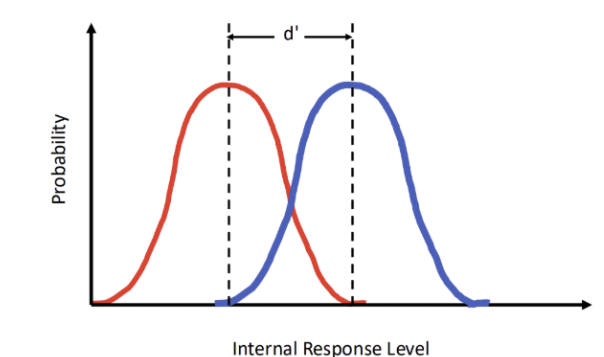
• or the difference between Stimulus 1 and Stimulus 2.
This is conceptualised as the separation between the noise and the signal plus noise curves → the greater the separation, the greater the sensitivity.

Criterion - decision bias
An internal threshold that is set by the observer. • If the internal response is above criterion, the observer gives one response. • Below criterion, the observer gives another response - can be positioned at any point on the x-axis, is set by the observer
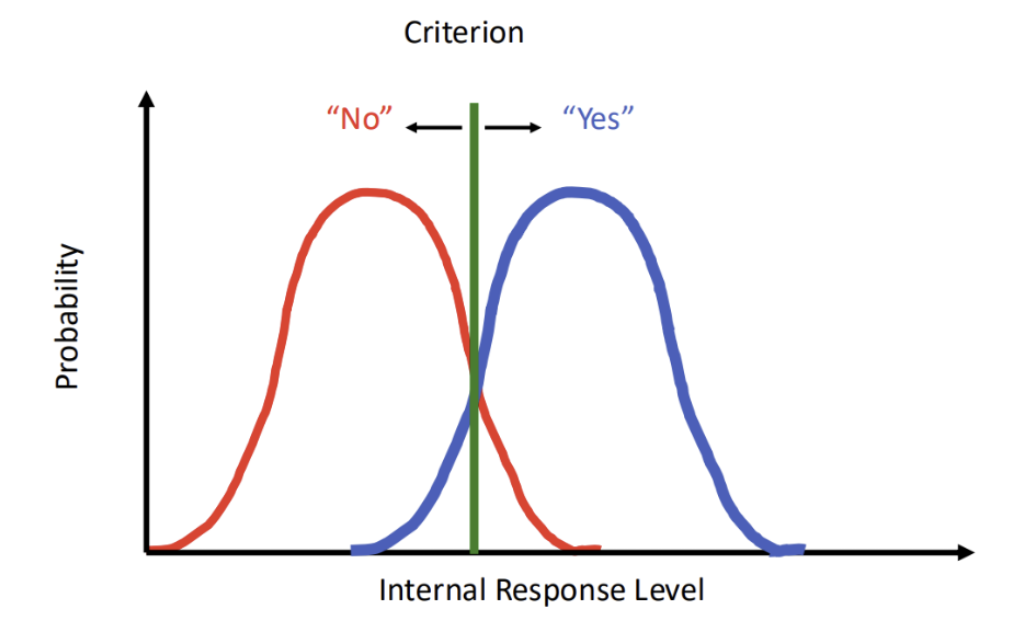

What are the types of results possible for a signal detection theory experiment?
Hit rate - Stimulus is present and the observer responds “Yes.”
False alarm rate - —Stimulus is present and observer responds “No.”
Misses - Stimulus is not present and observer responds “Yes.”
Correct rejection—Stimulus is not present and observer responds “No.”
Structure of a signal detection experiment
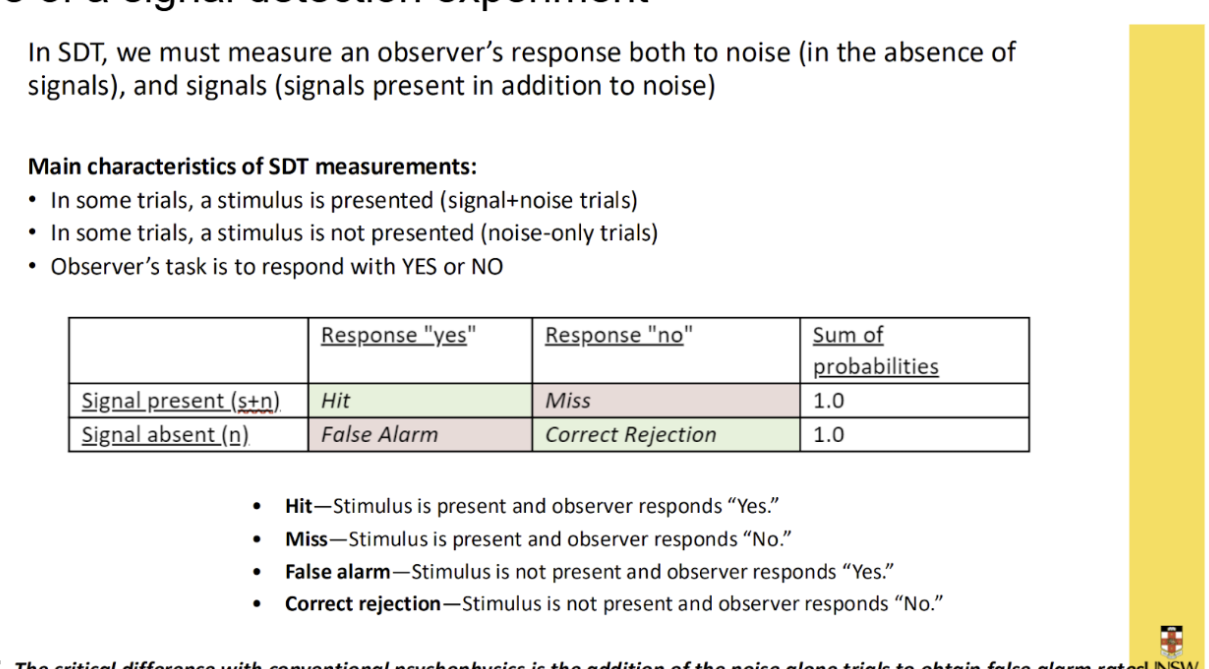

What is the critical difference with convention psychophysics is the addition of noise trials to obtain false alarm rates?
The critical difference with conventional psychophysics is the addition of the noise alone trials to obtain false alarm rates.
What is the ‘visual brain’?
The over 20 regions of richly interconnected areas that is devoted to vision,
Consist of the dorsal (how) processing the object location vs. the ventral pathway (what) processing of attributes and identity.
What is parallel organisation?
2 x pathways of which different processing channels parse signals into different streams of which are specialised to a specific type of input. For example ventral vs. dorsal pathways of which one processes motion and the other attributions.
What is modular organisation?
The visual brain consists of many different visual areas, which are functionally specialised to process and perceive different attributes of the visual scene.
What is the binding problem?
The parallel input signal must be integrated in the cortex to provide a unified and coherent percept – how does this happen?
What are illusory conjunctions?
a perceptual error where features of different objects, like color and shape, are incorrectly combined to form a new, false object
Shows that we need to integrate all features of an object, features of objects are ‘floating’ and segregated, in order to properly know the features, you need to pay attention.
What does it mean when we say the visual system is a hierarchical organisation?
Sequential processing stages increase in processing complexity from early to later visual brain areas. In order to activate specific neurons at latter stages, you need to have very specific and complex stimuli.
What also changes as visual processing continues?
There are progressively large receptive fields as time goes on, this is to help aid the integration of simple, spatially separated features into more coherent units of perceptions. You need to see ‘more’ in order to see a complex image
What is the inferotemporal cortex?
Part of the ‘what’ pathway, which is situated in the lower portion of the temporal lobe, this creates very large receptive field sizes. This part of the cortex is organised using columns of which respond to very specific and complex factors. One example of this is the specific activation of the IT cortex in responses to faces, seen in data around monkey recognition of faces .
What is the fusiform face area?
an area of the inferotemporal cortex that responds to faces more than usual.
What is the parahippocampal place area?
an area of the inferotemporal cortex that responds more to places.
What is the Extrastriate Body area?
an area of the inferotemporal cortex that responds more to body parts.
Did infants show the same response in the FFA, PPA and EBA as adults?
Found that infants as young as 2-9 months have tuning of areas of the brains to specific objects, suggests that this feature is either innate or learnt very early.
What is evidence for the modular (specialised) ventral visual organisations?
essentially different types of Apperceptive Agnosia, Associative Agnosia (Prosopagnosia and Objective Agnosia) and integrative agnosia.
What is Apperceptive Agnosia?
widespread damage to early visual areas, and areas that connect the early areas to later areas ( V1, V2 , V3)
This results in a profound ability to recognise and copy object.
Results in visual simultagnosia → when there is more than one object in a scene they cannot process these together.
Will fail colour blindness tests.